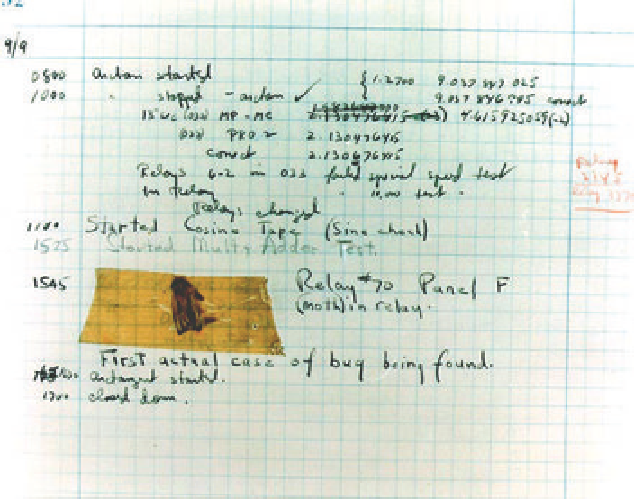Information Technology Reference
In-Depth Information
like to have me compute the coefficients of the arc tangent series, for
Thursday. Again, what could I say? “Yes, Sir.” I did not know what on earth
was happening, but that was my meeting with Howard Hathaway Aiken.
7
Hopper is credited with introducing the word
bug
into computer terminology
after her team found a real insect, a moth, stuck in one of the machine's relays
(
Fig. 3.5
). At the end of the war, Hopper chose to remain at Harvard, program-
ming first the Mark I and then the Mark II machines. But in 1949 she defected
from Aiken's camp and joined the opposition, the Eckert-Mauchly Computer
Corporation in Philadelphia, which Aiken had dismissed as a foolish idea. This
company was Eckert and Mauchly's brave effort to commercialize their EDVAC
ideas by building the UNIVAC computer. At the time, there was great skep-
ticism as to whether there was a significant market for business computers.
Hopper later joked:
B.3.4. Howard Aiken (1900-73), an
American physicist and computer
pioneer, proposed to IBM in 1937
the idea of constructing a large-scale
electromechanical computer. By
1944, the computer, known as Mark
I, became operational. The machine
was fifty-five feet long, eight feet
high, and about two feet wide.
Mauchly and Ekert had chosen their building perfectly. It was between a junk
yard and a cemetery, so if it all went wrong . . . they could throw the UNIVAC
out of one window and themselves out of the other.
8
Following along the same lines as Wilkes and Wheeler in Cambridge,
Hopper and her team began to code their programs in UNIVAC assembly
language. In doing this, she produced a program that would translate the
assembly code into the binary machine code automatically, as Wheeler had
done with his Initial Orders program. However, Hopper had much larger
ambitions than using just primitive abbreviations for the low-level opera-
tions of assembly language. She began to investigate whether it was possible
to write a program using expressions that more closely resembled every-
day English. Initially focusing on creating a more natural language for sci-
entific computing, Hopper experimented with a language called A-0. She
introduced the term
compiler
for the software system she created to translate
Fig. 3.5. The first recorded appearance
of a computer “bug” dates from
1947. Grace Hopper is credited with
introducing the word into computer
terminology after her team found a real
insect, a moth, stuck in one of the relays
of the Mark II computer. They removed
the insect and taped it into the logbook.


Search WWH ::

Custom Search